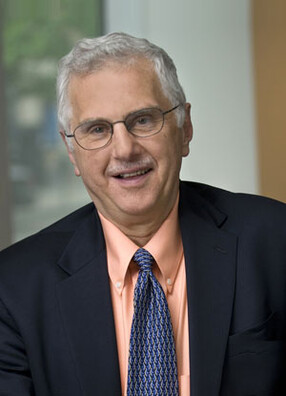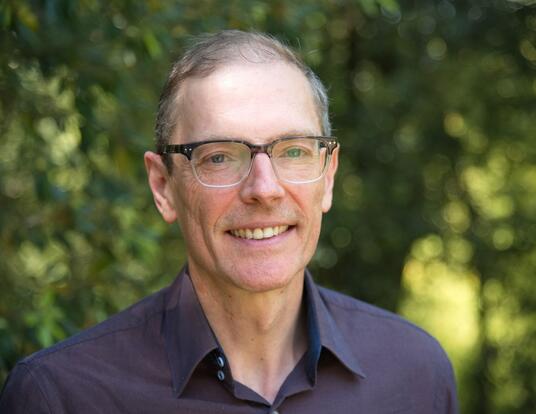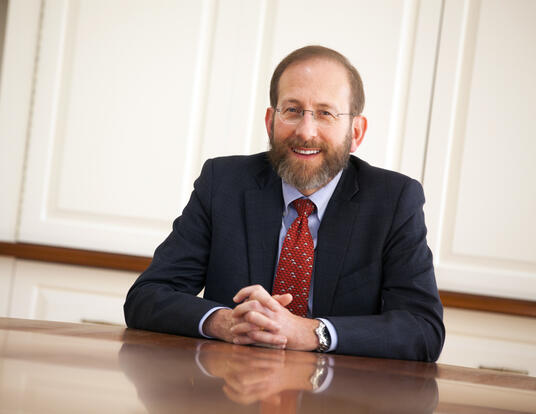A Conversation with Bruce Alberts
A global leader on matters of science policy, Alberts (AB ’60, PhD ’66) also works to improve science education locally.
Bruce Alberts, AB ’60, PhD ’66, is the editor in chief of Science and a former two-term president of the National Academy of Sciences. Now Professor Emeritus of Biochemistry and Biophysics at the University of California, San Francisco (UCSF), he is one of the authors of The Molecular Biology of the Cell, a standard university textbook in its fifth edition. He is also one of the first three science envoys appointed by President Barack Obama to engage with Muslim-majority countries on issues of science and technology. For all his global impact, however, Alberts spends a considerable portion of his time thinking very locally — thinking about what happens in a middle-school science classroom in Boston, for instance. He’s committed to improving the quality of science and mathematics education in American schools, spearheading initiatives that reward a more robust partnership between academia and on-the-ground reform efforts, and then exploring the research and policy implications in the pages of Science. He spoke to Colloquy about his current interests.
Talk about your involvement in science education reform at the elementary and middle school levels.
I think of it as making a science of education: Using evidence and continuous feedback about what happens to students in our education system at all levels, and trying to build a continuously improving education system from that evidence. We’re very far away from that type of model now.
K–12 education in the United States is mired in politics. No Child Left Behind, for example, started out with a reasonable idea — to introduce accountability — but it ended up distorting the entire system, and we kept with it for more than a decade because politicians can’t admit that they don’t do things perfectly the first time.
The world of education is very complicated — it’s at least as complicated as biology. But as scientists we would never think of saying, well this is the way that the cell works, and we’re going to prove it. Instead, we would say, this is our best guess as to how to do something — in this case, improve education — and what we’re going to do is to introduce along with any policy a serious research process that finds out exactly what happens when this policy is applied.
Say more about this scientific approach to education reform.
When I was at the Academy, from 1993 to 2005, we did a lot of work on the science of education, and the first product was a book, How People Learn: Brain, Mind, Experience, and School (National Academies Press, 1999, 2000). We were asking: What do we know from the research done in psychology departments about how people learn, what is its applicability to schools, and how should this change the way we think about teaching and learning? How People Learn was enormously successful, and it is now used widely in teacher preparation courses and in designing curricula.

But we also tried to do something much broader, which was to ask the question, Why is knowledge from research used to continually improve agriculture and medicine, for example, but not used to continuously improve education?
The committees charged with answering this question found that educational research is not very effectively used in our K-12 schools in large part because we don’t do the research in the schools. We do it in lab settings and don’t take into account the complications in real schools — the way schools operate, the conditions within a school. We need to lower the barriers between the research community and schools.
The committees proposed an initiative called the Strategic Education Research Partnership (SERP), an effort for which I presently serve as board chair. SERP develops productive collaborations among educators, researchers, developers, and policy makers. It establishes field sites — school districts that enter into long-term partnerships with SERP researchers — that identify problems and test programs aimed at addressing them in classrooms. Boston was the first field site, under the direction of a distinguished Harvard professor, Catherine Snow [the Patricia Albjerg Graham Professor of Education].
When did you first see that science education needed improvement?
It first became glaringly obvious when my wife became PTA president in the public school system in San Francisco in the early 1980s. She spoke at every school board meeting, and they were broadcast on the radio — and since she was speaking, I had to listen. And I realized how divorced our school board was in San Francisco from the serious issues of teaching and learning.
I also realized that the San Francisco school system — where all my kids went to school — was like the developing world with regard to resources available for science. And here was UCSF, a very wealthy and advanced entity, in the middle of this deprived world of the schools. So we started a massive Science and Health Education partnership — originally it was to transfer equipment we were getting rid of to teachers, but it ended up being much more. Now we send some 300 graduate students and postdocs into the schools as volunteers every year.
How does the US stack up these days against other countries?
I just came back from China, and you can’t help but notice the kind of investments they are making in their future. Long-term investments in education, building huge new campuses for their universities, investing huge amounts in science and technology. My major political goal would be to get more leaders of Congress over to China to see what they’re doing. They have no idea.
Describe your role as one of the President’s science envoys.
Six of us have been appointed to work with Muslim-majority nations, and I was assigned to Indonesia and Pakistan. I’ve spent the majority of my time thus far in Indonesia.
One of the things I discovered is that there is essentially no merit-based competition for scientific research funds in Indonesia. Their investments in science are relatively small, and the funds are all given out to institutions to redistribute, so the best young people have no opportunities to show what they can do. The result is a collaboration with the World Bank in Jakarta to help Indonesia develop a National Science Foundation–like granting system that will reward excellence and help develop a merit-based system with regard to who gets resources in Indonesian sciences.
We’re just at the beginning stages, but the US has helped many countries set up merit-based funding systems, including in China and Mexico, so this isn’t the first time.
The other major program I started in Indonesia is called Frontiers of Science. It’s part of a program that brings together 40 of the best young scientists in the US with their contemporaries in a partner country at an annual symposium. The idea is to create personal ties of trust and collaboration, using science and engineering, that hopefully will help stabilize the world, if we can get enough of it going.
In 1998, I attended the second China–US Frontiers of Science. One of the leaders on the Chinese side, Chen Zhu, is now the minister of health in China. Every time I go to China, I have breakfast or dinner with Chen Zhu and see how he’s doing. This is the point: Future leaders get to know each other and develop a realistic approach to the other country, not based on fear or competition.
What has it been like to move from scientist to advocate?
Most scientists are advocates, they just have no time to advocate. And they also don’t have much broad exposure to what science can do in the world. My 12 years in the Academy took me all over the world, to remote places in Africa, to rural Indian villages — places where I could see that thanks to the efforts of local scientists, there had been a huge difference in the life trajectories of poor people.
So I talk about the opportunities — as I just did in China — to spread the benefits of science to a much broader range of people. Of course, when you say that, you’re not talking about the same kind of science you do in the chemistry labs at Harvard. You’re talking about the science that creates food for people who are used to starving every year during shortages in Africa, or you’re talking about trying to bring enterprises to rural villages in India that are based on science, like growing mushrooms, building dairies, or making biopesticides.
You speak of the importance of promoting the tolerance and openness of science. What do you mean?
Well, the whole enterprise of science is pretty amazing. It’s an agreement between people that ‘I will honestly report what I find and show you how I did it, so that you can then build on my work and check it.’ Science is a very cooperative enterprise. It absolutely relies on honesty. You have to have high moral standards, and you have to punish people who are dishonest, and you have to reward cooperation — otherwise it doesn’t work. The values of science — reliance on evidence, and rational analyses from evidence — are critical for democracies. And if you look at our political systems, we need that more than ever in all nations, including the United States.
From the Fall/Winter 2011 edition of Colloquy.
Get the Latest Updates
Join Our Newsletter
Subscribe to Colloquy Podcast
Simplecast





